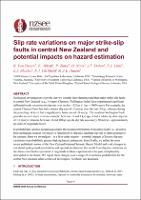| dc.description.abstract | Geological investigations over the last two decades have demonstrated that major strike-slip faults
in central New Zealand (e.g., Awatere, Clarence, Wellington faults) have experienced significant
millennial-scale variations in slip rate over the last ~12 kyr (1 kyr = 1000 years). For example, the
central Clarence Fault has had a dextral slip rate of ~2 mm/yr over the last ~8 kyr, whereas during
the preceding ~4 kyr it had a significantly faster rate of ~9 mm/yr. The southern Wellington Fault
provides an even more extreme example: between ~5 and 8 kyr ago, it had a relatively slow slip rate
of 1-2 mm/yr, whereas between ~8 and 10 kyr ago its slip rate was nearly 20 mm/yr - approximately
an order of magnitude faster.
In probabilistic seismic hazard assessment, the hazard contribution of an active fault (i.e., an active
fault earthquake source) is typically a function of its slip rate, and that slip rate is often assumed to
be constant. Here we investigate – in a first-order manner – potential impacts of known slip rate
variations on probabilistic ground shaking hazard estimation. Specifically, we utilise the most
recent published version of the New Zealand National Seismic Hazard Model and track changes in
calculated peak ground acceleration and spectral acceleration that result from slip rate variations on
the above-cited faults equivalent in magnitude to those experienced in the past, and plausibly
anticipated in the future. We report these changes over a range of exceedance probabilities for the
central New Zealand urban centres of Wellington, Blenheim and Kaikōura. | |

